Who are the Five Great Wisdom Buddhas and Why Are They So Important? How to Visualize and Practice the Five Dhyani Buddhas

Who are the five Great Conquering Buddhas and what are their five Wisdoms? Why are they so important in daily Mahayana Buddhist practice? How are they different from Shakyamuni Buddha, who was born into our world?
In this feature we’ll introduce the important Five Buddha Mandala, and the symbolism and mantras of the five Buddhas. In other presentations we’ll explore each Buddha family one-by-one, with their practices and mantras.

The Five Wisdoms and Five Buddhas
The Five Buddhas are often called the Buddhas of the Five Wisdoms or the Buddhas of the Five Directions. This map-like language is not accidental.
The mind universe of this mandala exists first in our minds. Before you think “how small is that?” remember that the average human brain has 100 billion neurons and around 100 trillion synapses. The Milky Way galaxy, our home galaxy, is roughly 100,000 light-years across and only has a mass of 100 billion solar masses — mirroring the number of neurons in our brain.
The mind map is a vast expanse, and it is in the mind we meet the Five Buddhas.
Aside from the wonder of the experience, why undertake the journey to meet the Five Wisdom Buddhas? Like our minds mirror our galaxy, the five Buddhas mirror the five wisdoms that are the essence of Buddhist practice.

Shakyamuni Taught Remedies for the Five Poisons
Shakyamuni Gautama Buddha, born in five sixty-three BC, awoke to the true nature of reality and the true nature of suffering. He gave us remedies for the five poisons that keep us trapped in Samsara, preserved in Sacred Sutras. These poisons, sometimes thought of as inner demons, are anger, attachment, pride, jealousy, and ignorance.
He taught us that we can all become Awakened or Buddha by teaching various skillful means, beginning with the four noble truths and the eightfold path.
He also taught us how to transform these five poisons into the Five Wisdoms. One of these methods is meditating on the mandala of the Five Wisdom Buddhas. Each has various methods, practices, mantras, praises, and each specializes in one poison, remedied by one wisdom.

Five Great Wisdoms
The remedies can be summarized as the five great Wisdoms. One way Shakyamuni taught us to relate to the Wisdoms is by practicing the Five Buddhas through building a relationship with meditation and practice.
These Five Buddhas are often called the Dhyani Buddhas, or Cosmic Buddhas or the Five Conquerors.

Buddha Family: Remedy for Delusions
For example, people who remain trapped in Samsara due to negative karmic actions arising from the poison of delusion and ignorance, would turn to Vairochana Buddha in the center of the great mandala, who helps us with his Wisdom of Dharmadatu, or the mind purified of obscurations. He helps us see things as they truly are.

Karma Family: Remedy for Jealousy
If our issue was Jealousy, always envying others and generating negative karmic actions, then we might turn to Amoghasiddhi in the North, whose All-Accomplishing Wisdom and activity can help us.

Vajra Family: Remedy for Anger
Or, if we were dealing with issues of anger, if that is the poison that persistently arises in our samsaric life as it does for many people, then we would turn to Akshobhya Buddha in the east. He helps us with Mirror-Like Wisdom.

Jewel Family: Remedy for Pride
On the other hand, if our main issue is the poison of pride, always guarding our reputation or hoarding selfishly, then we might be advised to turn to Ratnasambhava in the south, and his golden wisdom of Equality and Equanimity.

Lotus Family: Remdy for Desires
Lastly, and to many of us the most important, are the inner demons or poison of desires or attachments, always wanting this and that and never satisfied. For desires and attachments, then the eternally popular Amitabha Buddha in the West is the main practice recommended, with his Wisdom of Discernment.
Map of the Mind Universe: Mandala
The significance of the Map of the Mind Universe of the Five Buddhas is extraordinarily profound. It invites us to be the explorer, to be the adventurer who goes on a journey to meet the great Wisdom Buddhas in our own minds.
We have no need to journey out into the vastness of our galaxy, when our mind mirrors the spectacular spaciousness of this cosmos.

We, the seekers of wisdom, who strive for the release from the five poisons can journey in the mind to meet the Five Buddhas and their entourage. These journeys can help end our suffering.
In this metaphorical journey, it is helpful to have a map, in Buddhism known as a mandala. Our coordinates on the map are the symbolism of each Buddha and their mantras.

In this feature, we’ll navigate the map and its symbolism and introduce the Five Buddhas. In other presentations we’ll explore the five Buddhas one-by-one.
Where does the map point? The mandala is a map of the five wisdoms, the five Buddhas, the five Buddha families with entourages, each with their own Wisdom to teach us.

Symbolism are the Map Coordinates
What are the coordinates on this metaphorical map? They are profound and sacred symbols.
There is a reason that mandalas are so important to Mahayana and Vajrayana Buddhism. They are meant to be visualized, expressing a multi-dimensional map of the universe in the context of the Buddhas and the Pure Lands.
The language of the mind is not words. Symbols, colours, and images are the universal language of all minds, as Carl Jung pointed out in his analysis of dreams. Dreams are visual. The mind recalls memories in images. The eminent Carl Jung explained the universal language of symbols:
“Every psychological expression is a symbol if we assume that it states or signifies something more and other than itself which eludes our present knowledge.”

Since most Buddhist practice is mind work, such as sitting meditation, watching the breath, visualizing the Buddha, or intricate deity practices, the symbols, images, and colors become essential rather than arbitrary.
They express the unknowable in a way the mind can explore comfortably. For this we need the language of symbols.
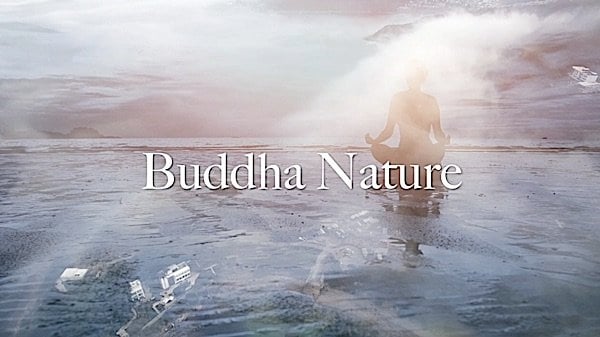
All Beings have Buddha Nature
Doctor Alexander Berzin, noted Buddhist teacher, explains:
“Buddha-family traits, refer to aspects of Buddha-nature that all of us have, even worms. In general, Buddha-nature factors allow for or account for everyone being able to become a Buddha.”
Does this mean the Five Buddhas are imaginary? Not at all. We use imagination to visualize, not to fantasize. In the context of the Buddhist universe, the Five Celestial Buddhas are real, considered Sambhogakaya aspects of the Buddha.
They manifest in these enjoyment body aspects to teach us a particular wisdom, to offer a particular practice, and to help us meditate to overcome a particular poison, just as they’ve helped countless beings before us.

Visualization is Communicating Visually
We visualize not to be fantastical, but to connect with their real essence. Our minds prefer to communicate visually.
For example, if a Buddha manifests as red, such as Amitabha Buddha, the Buddha of Infinite Light, it is for a reason. In the language of the mind, which transcends modern associations, the universal associations of red are fire, warmth, love, setting sun, and energy.

In most of the world, red takes on even greater energetic significance with the magnetizing effect of good luck, celebration, compassion, happiness, and long life. This is why, for example, Amitabha’s Family are called Magnetizing or empowering Buddhas.
Amitabha’s red color communicates so much.
Five Universes to Explore: The Five Purelands
We will explore each of the galaxies of the Five Wisdom Buddhas in future presentations but we’ll summarize here for some helpful context and include their mantras.
- Each Buddha family has a Father Buddha representing Compassion and a Mother Buddha representing Wisdom.
- Each, have a mantra representing the essence of wisdom and a seed syllable. Each Buddha Family has a Pureland, which is the purity and manifestation of that wisdom and compassion in the pure, spacious mind of Buddha.
- Each has a color representing an activity, a Wisdom that focuses on a poison, an aggregate or personality called a skandha, a direction on the mandala, and an emblematic symbol.
Although they can all appear in various forms for specialized needs, which we’ll cover in future presentations, the main form is a peaceful form, appearing as a monk or bhikkhu, seated in lotus posture.
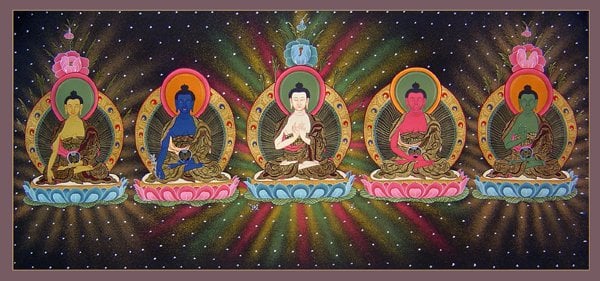
Center: Buddha Family of Vairocahana
In the center of the mandala is the Buddha Family of Vairochana Buddha, who is white in color, with his hands in the Dharma chakra, or Wheel turning mudra.
The Wisdom Mother Buddha is White Tara or Akasha Dhatvishvari. The White Color represents Pacifying activity, helping to pacify and calm our minds, diseases, purify our delusions, negative karma, doubts and fears.
The seed syllable is Om. The Bodhisattva of the White Budddha Family is Samantabhadra.
Together, the Buddha Family of Vairochana, helps us with the poison of ignorance or delusion with the Wisdom of Dharmadatu, the understanding of ultimate reality.
Vairochana’s Buddha Family symbol is the eight-spoked wheel, the Dharmachakra. As the Wisdom of the Dharmadatu, the Buddha family is associated with the element of space.
His sacred animal is usually the white Snow Lion which is often depicted on his throne. His pureland is Akanishta-Ghanavyuha .
His seed mantra is:
Om Vairochana Hum

West: Padma Family of Amitabha
In the west of the mandala is the Padma Family of Amitabha Buddha, who is red in color with his hands in the mudra of meditation. Amitabha is the Buddha of Dharma Speech, symbolized by red.
The red color also represents empowering and attracting or magnetizing activity, helping to attract auspicious factors to help us overcome our obstacles. Red is also a protective color. His seed syllable is Hrih.

The Wisdom Mother is Pandara.
The Bodhisattva is Avalokiteshvara also called Guan Shi Yin or Chenrezig.

Together, the Padma or Lotus Family of Amitabha helps us with the poison of desire and attachment, cutting through with the Wisdom of Discernment, or correct perception.
Amitabha’s Padma Family symbol is the lotus, a symbol of purity and compassion. As the Wisdom of the Discernment, the Padma Family are associated with the element of fire.
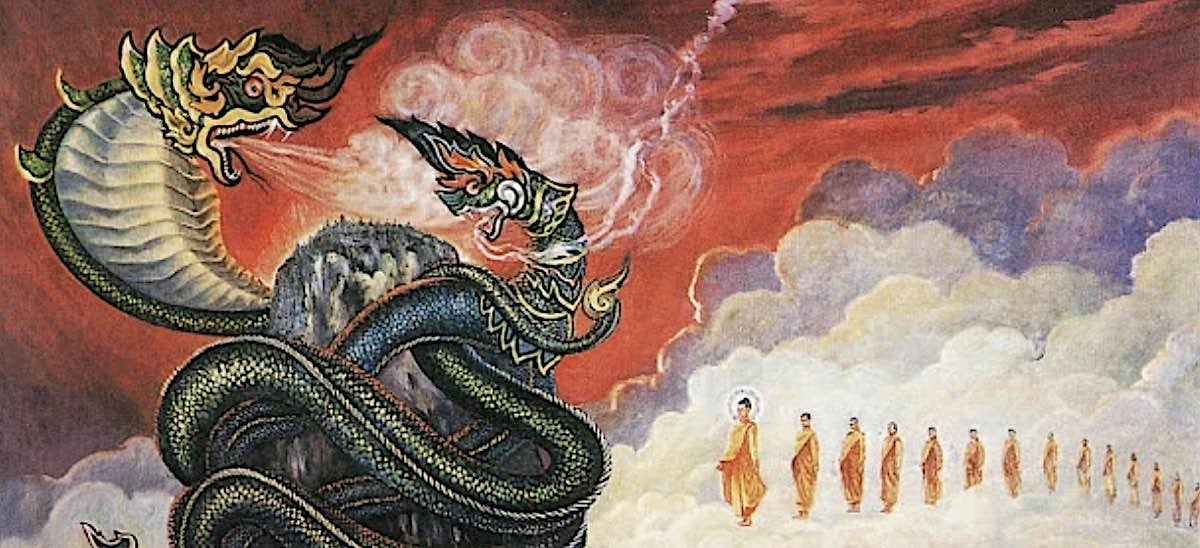
His sacred animals are usually the peacock and dragon. His glorious Pureland in the west is the most famous of Purelands, called Sukhavati, or the Happy Realm.
His mantra is:
Om Amitabha Hrih
He has many other mantras, including:
Om Ami Deva Hrih (in Tibetan Om Ami Dewa Hrih)

North: Karma Family of Amoghasiddhi
Turning clockwise around the mandala, next is the Karma Family of Amoghasiddhi Buddha in the North. He is green in color, symbolizing windy activity, with his hands in the mudra of fearlessness.
The green color represents all activities, the windy hurricane force of wisdom and compassion blowing into our lives. His seed syllable is ah.

The Wisdom Mother Buddha is Glorious Green Tara. The Bodhisattva of the Karma family is Vishvapani.
Together, the Karma or Activity Family of Amoghasiddhi helps us with the poison of jealousy or envy, cutting through with All Accomplishing Wisdom.

Amoghasiddhi’s Karma Family symbol is the double vajra, also called a vishva vajra, a symbol of the entire mandala of five Buddhas. This represents their activity in all realms, as Amoghasiddhi and Tara together are the activity of all the Buddhas.
The Karma Family are associated with the element of wind and air.

The sacred animals are usually the garuda and the windhorse. The Karma family pureland in the north is Karma prasiddhi or Prakuta.
His mantra is:
Om Amoghasiddhi Ah Hum

East: Vajra Family of Akshobhya
Going clockwise, in the east is the Vajra Family of Akshobhya Buddha. He is blue in color, symbolizing water and purity, with his right hand in the mudra of earth touching and a vajra in his left hand.
The blue color represents the coolness of water, which is why its often associated with medicine and healing and also the cooling of wrath or calming of anger.
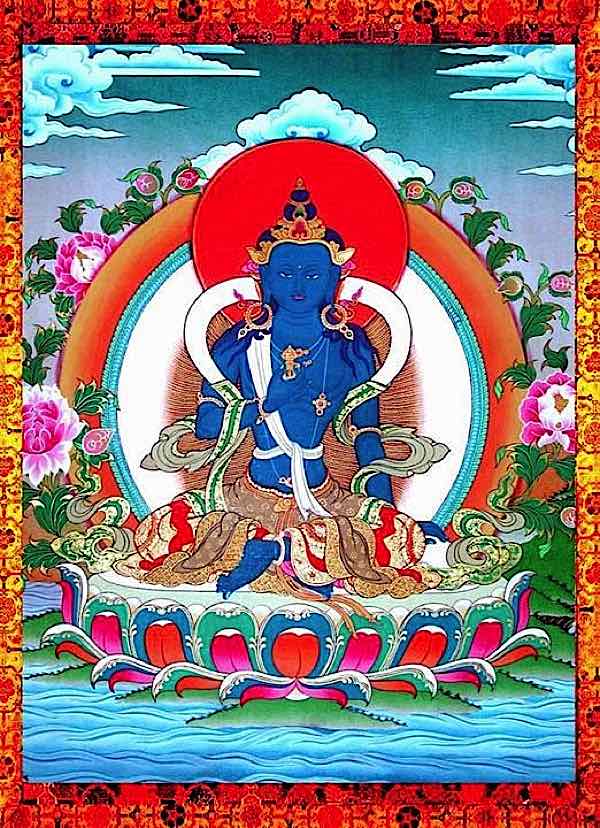
Blue is often the color visualized to help cool our anger, like a splash of cool water. Blue is the color of the activity of transforming wrath. Blue is also symbolic of a mirror or reflection, the Vajra family’s Mirror-Like Wisdom. Wrathful deities are often blue to symbolize “cooling your anger.”

The Wisdom Mother of the Vajra Family is Lochana. The Bodhisattva is the great and powerful Vajrapani.
Together, the Vajra Family of Akshobhya helps our anger, with Mirror-like Wisdom, or the wisdom of reflection.
Akshobhya’s Vajra Family symbol is the powerful vajra.
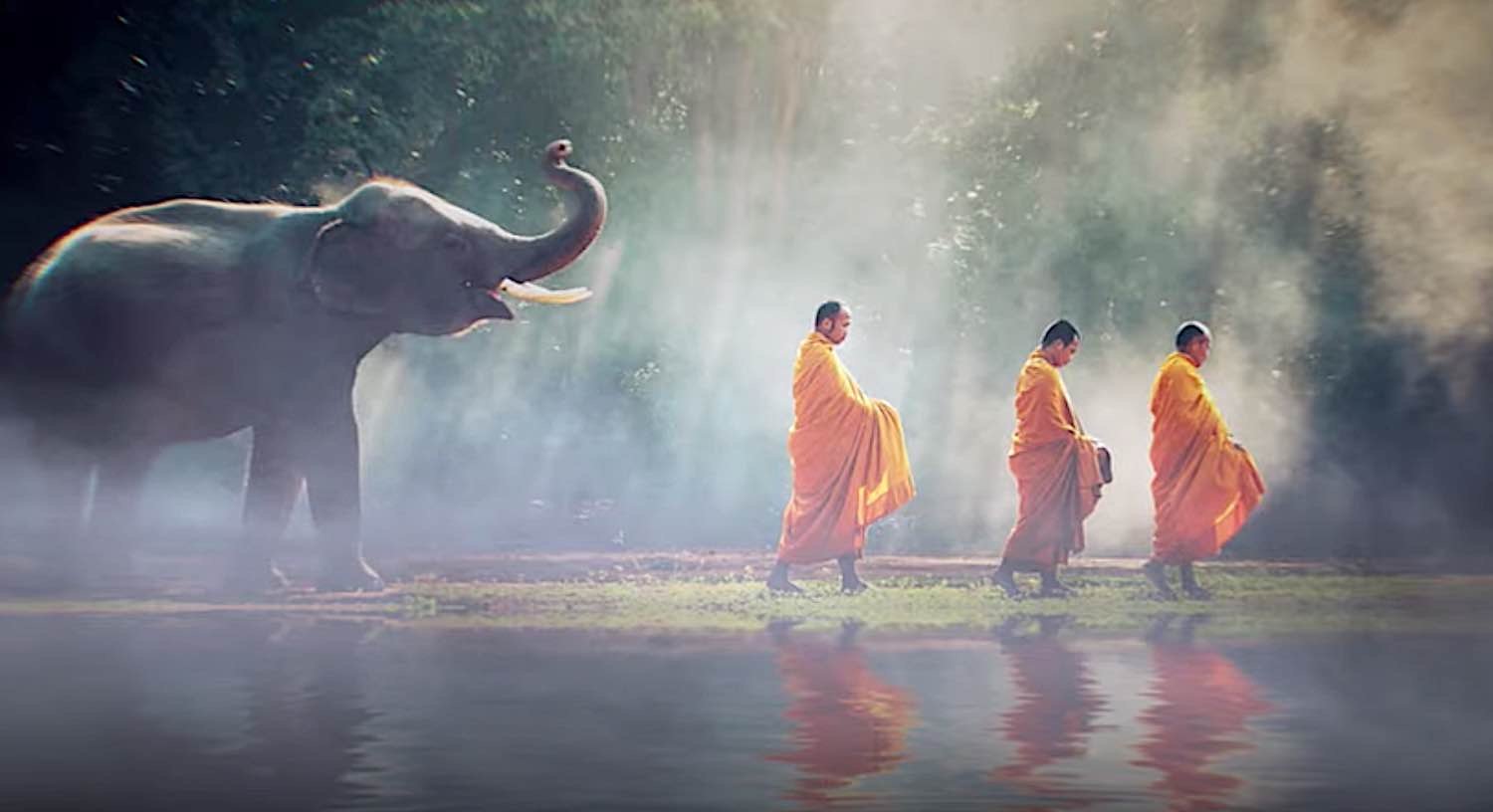
His sacred animal is the elephant and sometimes the snow lion. His glorious pureland in the east is Abhirati.
His mantra three times is:
Om Akshobhya Hum
South: Ratna Family of Ratnasambhava
Finally, in the south is the Ratna or Jewel Family of Ratnasambhava Buddha. He is yellow or gold in color, symbolizing earth, with his right hand in the mudra of giving and a wish-granting jewel in the other.
The yellow color represents the activity of enriching, generosity, prosperity and auspiciousness and the earth. It also represents rootedness and renunciation. His seed syllable is Tram.

The Ratna Family Wisdom Mother is Mamaki. The Bodhisattva is Ratnapani.
The Ratna or Jewel Family of Ratnasambhava helps us overcome the poison of Pride and Arrogance with the Wisdom of Equality and Equanimity.
Ratnasambhava’s Jewel Family symbol is the wish-granting jewel.
The Ratna Family are associated with the element of earth. Their activity is auspiciousness and enriching. The skandha or personality of the family is feeling.
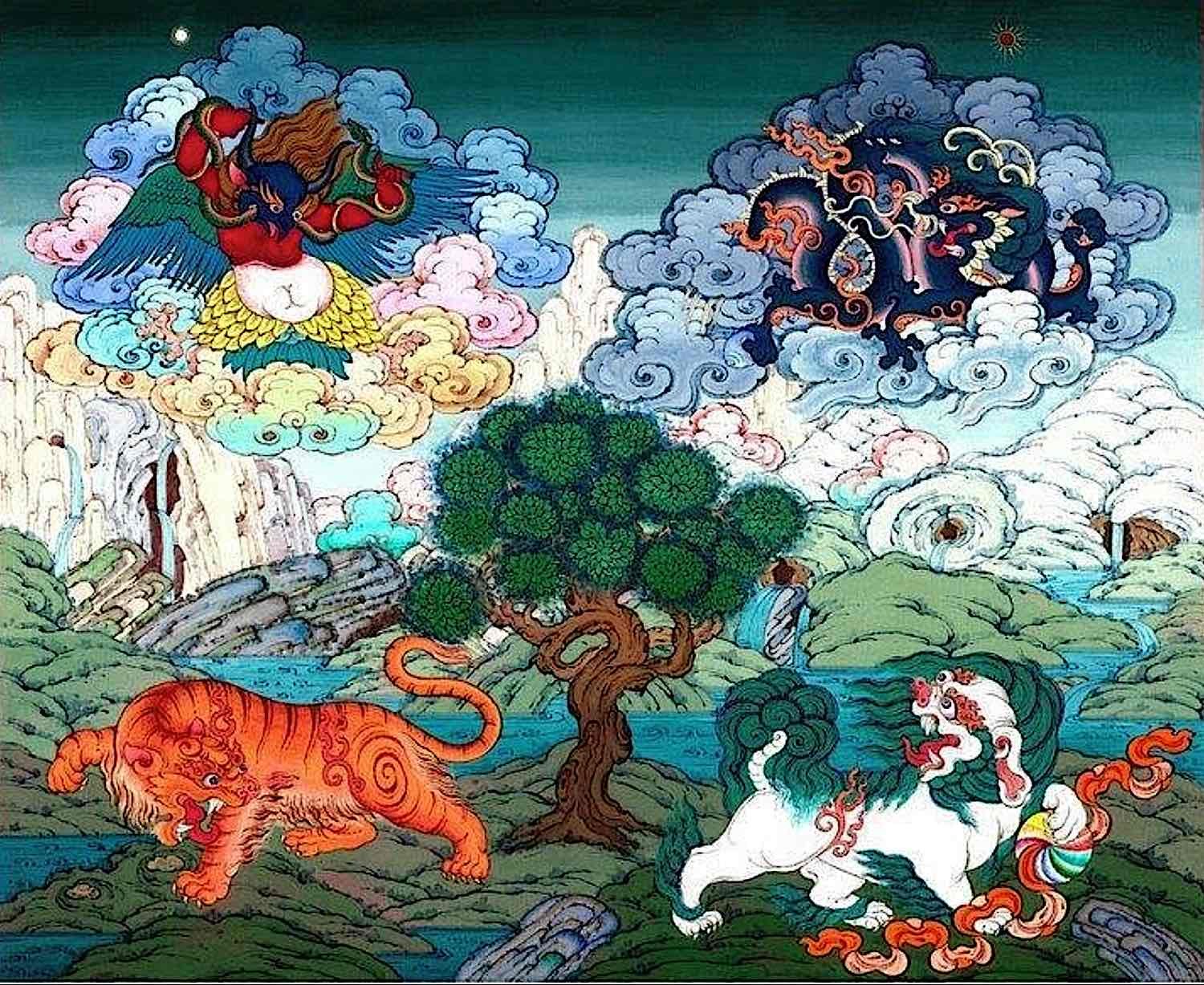
The sacred animals are the horse and the tiger. The Ratna family’s glorious Pureland in the south is Shrimat
His mantra three times is:
Om Ratnasambhava Tram

Practicing the Five Buddhas: A Short Practice
The Five Wisdom Buddhas can be both a collective daily practice, or we can focus on one Buddha.
To practice the Five Buddhas, we prostrate and take refuge in the Three Jewels, the Buddha, the Dharma and the Sangha. When we do this we know that Buddha means all Buddhas, Dharma means all Buddha Dharmas and Sangha means the Supreme Sangha of Bodhisattvas and disciples.
We visualize our field of merit, the five Buddhas with White Vairochana in the center of the mandala, Red Amitabha in the west, Green Amoghasiddhi in the North, Blue Akshobya in the East, and Yellow Ratnasambhava in the south.
Usually we say something like:
“I Take Refuge in the Buddha, the Dharma and the Supreme Sangha until I achieve Enlightenment for the benefit of all sentient beings.”

We say this three times, while prostrating each time.
We then either make mental visualized offerings or real visualized offerings, confess our shortcomings and promise to refrain from future negative karma.
We chant the five mantras while visualizing the five purifying lights emanating from the five Buddhas: White from Vairochana, Red from Amitabha, Green from Amoghasiddhi, Blue from Akshobya, and Yellow from Ratnasambhava. The light fills the entire universe, blessing all beings. The light then returns into our own hearts, blessing us and purifying us of all negativities.
We then dedicate the merit for all sentient beings usually by saying something like: “I dedicate the merit of this practice to the cause for Enlightenment for the benefit of all sentient beings.”
Practicing Individually
They are also individual practices. Our teacher might give us a particular Buddha — or the Bodhisattva or mother of the family as our Yidam or core practice. This is normally chosen based on our main obstacles.
If our main obstacles are attachment and clinging, our teacher may recommend Amitabha Buddha, Avalokiteshvara, Kurukulla, or other “red forms.”
If our main obstacles are anger-related, our teacher might recommend Akshobhya Buddha, Vajrapani, Black or Blue Tara, or other “blue” forms.
If our main obstacles are Jealousy, envying our neighbors, craving what isn’t ours or selfishness, we might find ourselves practicing Amoghasiddhi or Green Tara.
If our main obstacles related to Pride and arrogance, we would likely be drawn to practices of Ratnasambhava, Yellow Tara, Vasudhara or other Yellow forms.
For obstacles relating to Delusions and Ignorance we might practice Vairochana, Vajrasattva, White Tara or other White forms.
We can practice them all, as a group mandala visualization with mantras, or focus on one family, depending on our needs.
Even if we focus on one Buddha in our practice, it is meritorious to Take Refuge and chant the mantras of all five Buddhas daily.
Watch for the other featuresin this series on the Five Wisdom Buddhas. May all beings benefit. We dedicate the merit of this presentation to the cause for Enlightenment for the benefit of all sentient beings.
More articles by this author

Protection from all Harm, Natural Disaster, Weather, Spirits, Evil, Ghosts, Demons, Obstacles: Golden Light Sutra: Chapter 14

Guru Rinpoche is ready to answer and grant wishes: “Repeat this prayer continuously” for the granting of wishes
Search
Latest Features
Please support the "Spread the Dharma" mission as one of our heroic Dharma Supporting Members, or with a one-time donation.
Please Help Support the “Spread the Dharma” Mission!

Be a part of the noble mission as a supporting member or a patron, or a volunteer contributor of content.
The power of Dharma to help sentient beings, in part, lies in ensuring access to Buddha’s precious Dharma — the mission of Buddha Weekly. We can’t do it without you!
A non-profit association since 2007, Buddha Weekly published many feature articles, videos, and, podcasts. Please consider supporting the mission to preserve and “Spread the Dharma." Your support as either a patron or a supporting member helps defray the high costs of producing quality Dharma content. Thank you! Learn more here, or become one of our super karma heroes on Patreon.
Lee Kane
Author | Buddha Weekly
Lee Kane is the editor of Buddha Weekly, since 2007. His main focuses as a writer are mindfulness techniques, meditation, Dharma and Sutra commentaries, Buddhist practices, international perspectives and traditions, Vajrayana, Mahayana, Zen. He also covers various events.
Lee also contributes as a writer to various other online magazines and blogs.

















